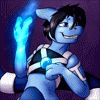Views: 1232
Submissions: 9
Favs: 6

Watcher | Registered: September 14, 2011 12:39:14 AM
Mostly a lurker.
Stats
Comments Earned: 15
Comments Made: 9
Journals: 2
Comments Made: 9
Journals: 2
Recent Journal
As Reality Except Where Noted (G)
11 years ago
I'm a fantasy nerd. I prefer settings where the bow is favored over the gun and walking is still considered a valid way to get between locations. I particularly like them because thanks to grandpappy Tolkien, fantasy settings are under no obligation to be set in our universe. Things aren't quite the same over in Sci-Fi land, where you almost never see the story set in anything other than a hypothetical future (or past, if you want to get screwy) of our own civilization. I think that's part of the draw of Star Wars. Despite the classic line of "a long time ago in a galaxy far, far away," Star Wars isn't a sci-fi so much as it is a fantasy story set in space.
However, when I do feel like drinking from the sci-fi well, this grounded nature is actually appealing to me. It's a bit like a Rube Goldberg machine, introduce a new concept to our world and observe how things are forced to shift to adapt to it. Usually the first element is of course "practical space travel." But the closer we get back to our world, the more we recognize it and distance ourselves from space fantasy, the more careful you need to be with it. Once you reach Next Sunday A.D., any sci-fi element pretty much needs to be directly tied to the plot or it's just a distraction.
Let's take the Godzilla franchise, for example. Apart from maybe two movies (Monster Zero and Destroy All Monsters, which both take place decades in the future), these movies are implied to be taking place in the year they come out. And in my personal opinion, the quality of each one can basically be traced to how close they stick to the real world apart from where the plot required it. The original Gojira had precisely two unreal elements: the King himself, and the Oxygen Destroyer used to kill him. Both of which are of course essential to the plot. Godzilla 1985 is one of my favorites, and to me the weakest element is the Super X hovertank thing, specifically because its existence wasn't necessary to the story, especially in the otherwise serious, grounded plot of a walking nuclear holocaust returning to terrorize a country after thirty years. And the weakest part of the Heisei era was the psychic subplot that ran along the entire series, which had no real purpose but to tase the plot back into action whenever it wrote itself into a corner.
Oddly enough though, the sillier things got the less you noticed it. By the second half of the Heisei era you had hovertanks, time travel, mecha, psychics, and magical insect gods running around. But by that point everything had been introduced and suspension of disbelief was simply far more lenient. Perhaps the easiest thing to add a Toho movie are the Maser tanks, which either shoot lightning or a freeze ray depending on which movie you're watching, but basically existed for no reason but to be an anti-kaiju weapon that never, ever worked. But in almost every incarnation their existence could pretty much be rolled with as a logical side effect of trying to do damage control on walking disaster areas, especially since it looked like a variation on what we already had.
The same trend applies to the MCU. In the first Iron Man the only sci-fi elements are the armor itself, a bunch of hologram interfaces, and Jarvis the AI. And while the AI was a bit weird at first it showed off Stark's genius and by the time Avengers 2 rolls around it'll be a central plot point. In Captain America the only Sci-Fi bits were HYDRA, supersoldiers, and the Tesseract. All three were central to the plot, and the last one directly set up the Avengers. Thor was Norse Narnia and can basically be excused from this comparison because it's a fantasy story that uses the real world for context. But by Captain America 2 we have winged jetpacks, robot arms, flying aircraft carriers and an offhanded mention of a sorceror, but we can get away with it this time because we've gone through so much in the series that it can be taken with a straight face. If you had tried throwing all that into Iron Man 1 it'd've been too silly.
Do I have an overall point to this? Sort of, I'm mostly thinking out loud. I think my point is that while weirdness can snowball, the closer you start to reality the slower you need to introduce unreal elements. The thing that kicked all this rambling off was recently watching Godzilla X Megaguirus, which was set in an alternate universe Japan where the capital had been moved to Osaka after Godzilla's original attack, a second attack prompting them to totally abandon nuclear power. It was all pretty interesting to watch as every sci-fi element - even the black hole launching killsat - existed as a direct response to the central element, Godzilla. All but one: a hoverjet used by the story's central organization. It wasn't a big thing, but its presence was so unnecessary to the plot that it was just distracting, like if you were watching a gritty crime drama where one of the detectives had a laser gun that nobody ever called attention to.
In conclusion, sort of, reality and fantasy exist on a sort of spectrum. The closer you get to reality, the more carefully you need to tie each fictional element into the plot, and then you're allowed to snowball from there, and by the time you reach a fantasy story the only things you need to leave "normal" are the things that separate fantasy from surrealism. I'm all for gun-toting cyborg raccoons hanging out with talking trees, but if you want to put them in modern-day New York you need to have a good reason for it.
However, when I do feel like drinking from the sci-fi well, this grounded nature is actually appealing to me. It's a bit like a Rube Goldberg machine, introduce a new concept to our world and observe how things are forced to shift to adapt to it. Usually the first element is of course "practical space travel." But the closer we get back to our world, the more we recognize it and distance ourselves from space fantasy, the more careful you need to be with it. Once you reach Next Sunday A.D., any sci-fi element pretty much needs to be directly tied to the plot or it's just a distraction.
Let's take the Godzilla franchise, for example. Apart from maybe two movies (Monster Zero and Destroy All Monsters, which both take place decades in the future), these movies are implied to be taking place in the year they come out. And in my personal opinion, the quality of each one can basically be traced to how close they stick to the real world apart from where the plot required it. The original Gojira had precisely two unreal elements: the King himself, and the Oxygen Destroyer used to kill him. Both of which are of course essential to the plot. Godzilla 1985 is one of my favorites, and to me the weakest element is the Super X hovertank thing, specifically because its existence wasn't necessary to the story, especially in the otherwise serious, grounded plot of a walking nuclear holocaust returning to terrorize a country after thirty years. And the weakest part of the Heisei era was the psychic subplot that ran along the entire series, which had no real purpose but to tase the plot back into action whenever it wrote itself into a corner.
Oddly enough though, the sillier things got the less you noticed it. By the second half of the Heisei era you had hovertanks, time travel, mecha, psychics, and magical insect gods running around. But by that point everything had been introduced and suspension of disbelief was simply far more lenient. Perhaps the easiest thing to add a Toho movie are the Maser tanks, which either shoot lightning or a freeze ray depending on which movie you're watching, but basically existed for no reason but to be an anti-kaiju weapon that never, ever worked. But in almost every incarnation their existence could pretty much be rolled with as a logical side effect of trying to do damage control on walking disaster areas, especially since it looked like a variation on what we already had.
The same trend applies to the MCU. In the first Iron Man the only sci-fi elements are the armor itself, a bunch of hologram interfaces, and Jarvis the AI. And while the AI was a bit weird at first it showed off Stark's genius and by the time Avengers 2 rolls around it'll be a central plot point. In Captain America the only Sci-Fi bits were HYDRA, supersoldiers, and the Tesseract. All three were central to the plot, and the last one directly set up the Avengers. Thor was Norse Narnia and can basically be excused from this comparison because it's a fantasy story that uses the real world for context. But by Captain America 2 we have winged jetpacks, robot arms, flying aircraft carriers and an offhanded mention of a sorceror, but we can get away with it this time because we've gone through so much in the series that it can be taken with a straight face. If you had tried throwing all that into Iron Man 1 it'd've been too silly.
Do I have an overall point to this? Sort of, I'm mostly thinking out loud. I think my point is that while weirdness can snowball, the closer you start to reality the slower you need to introduce unreal elements. The thing that kicked all this rambling off was recently watching Godzilla X Megaguirus, which was set in an alternate universe Japan where the capital had been moved to Osaka after Godzilla's original attack, a second attack prompting them to totally abandon nuclear power. It was all pretty interesting to watch as every sci-fi element - even the black hole launching killsat - existed as a direct response to the central element, Godzilla. All but one: a hoverjet used by the story's central organization. It wasn't a big thing, but its presence was so unnecessary to the plot that it was just distracting, like if you were watching a gritty crime drama where one of the detectives had a laser gun that nobody ever called attention to.
In conclusion, sort of, reality and fantasy exist on a sort of spectrum. The closer you get to reality, the more carefully you need to tie each fictional element into the plot, and then you're allowed to snowball from there, and by the time you reach a fantasy story the only things you need to leave "normal" are the things that separate fantasy from surrealism. I'm all for gun-toting cyborg raccoons hanging out with talking trees, but if you want to put them in modern-day New York you need to have a good reason for it.
User Profile
Accepting Trades
No Accepting Commissions
No Character Species
Shapeshifter (Usually a raptor.)
Favorite Music
Techno, Rock, Metal, Orchestral... lots of things.
Favorite TV Shows & Movies
The 13th Warrior
Favorite Games
Thief II: The Metal Age
Favorite Gaming Platforms
PC
Favorite Animals
Wolves or raptors.
Favorite Foods & Drinks
Meat.
Favorite Quote
"Nonsense, I have not yet begun to defile myself." - Doc Holliday
Contact Information











 FA+
FA+
























 scappo
scappo




